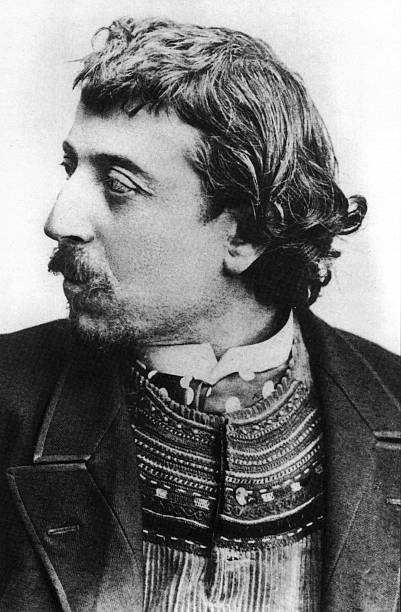


Painted clay
19.7 × 11.1 × 7 cm. (7 3/4 × 4 3/8 × 2 3/4 in.)
L.1988.62.63
Marie Henry (1859–1945), Le Pouldu, by 1894. [Galerie Zak, Paris, by 1939]; sold to Henry Pearlman, 1 July 1957; Henry and Rose Pearlman Foundation, after 1974.
In the spring of 1887, Gauguin set out for Panama, seeking to live in what he imagined to be a simple society. Events did not unfold as he had imagined: after several weeks of forced labor for the Panama Canal Company, he made his way to the French colony of Martinique. Illness brought Gauguin back to France, where he created paintings and ceramics based on his time in the tropics.
This figure is based on women’s faces and headscarves he observed in Martinique. The left arm and hand, however, were inspired by Javanese Buddhist reliefs that Gauguin knew from photographs he purchased in 1889 at the Paris World’s Fair. The sculpture was part of the decor that Gauguin and other artists made for the dining room of their landlady in Brittany, another region that interested them because it seemed “primitive.”
The sculpture’s material has historically been identified as terracotta, but recent analysis revealed a metal armature inside. It must, therefore, have been constructed of clay that was unfired and allowed to dry naturally, perhaps to seem more archaic.

Paul Gauguin (1848-1903)
Gauguin was fascinated by the idea of exotic cultures, seeing in them a purer way of life and an aesthetic that challenged the hegemony of Western art. One of the leading Post-Impressionists, Gauguin went beyond the depiction of the outward experience of modern life in order to represent inner visions and eternal symbols, abandoning the art world of Paris to explore such far-flung locales as Tahiti. Gauguin’s use of startlingly vibrant color combinations and flat passages of paint, together with his quest for alternatives to the European status quo, had an enormous effect on future generations of avant-garde artists, including many abstract painters.
Gauguin was born in Paris and spent part of his childhood in Lima, Peru, where he had maternal relatives. After returning to France, in his early adulthood he worked briefly as a stockbroker before abandoning his position to pursue art. In 1874 he studied with Camille Pissarro in Paris, immersing himself in the new forms of Impressionist painting. After many peripatetic years spent struggling to both produce works of art and support his family, in 1886 the nearly destitute Gauguin moved to the village of Pont-Aven in Brittany. Inspired by the verdant countryside and local customs, he created increasingly inventive stylized paintings and clay sculptures. Seeking to escape European strictures, Gauguin traveled to Panama and then Martinique, where he found inspiration in the lush tropical lifestyle. He returned to France after only few months, yet continued to integrate allusions to non-western cultures into his work.
Hoping to find an Edenic paradise where he could thrive creatively, in 1891 Gauguin set sail for Tahiti. When he arrived, he was disappointed to find that traditional island life had been incontrovertibly corrupted by colonialism. Nevertheless, he created paintings, sculptures, and woodcuts inspired by his idealized views of Polynesian life, combining them with religious imagery and other personal symbols and myths. After returning to France from 1893 to 1895, Gauguin again traveled to Polynesia. He attempted to live as a self-styled “savage” in Tahiti and the Marquesas Islands, notoriously taking up with very young local women and adorning his wooden huts with primitivizing woodcarvings, such as Te Fare Amu. In addition to creating artwork, Gauguin wrote about his experiences in Polynesia, most notably in his book Noa Noa. After suffering from syphilis and conflicts with colonial authorities, Gauguin died in 1903 in the Marquesas. His influence continued to grow, however, as evidenced in artistic movements such as Expressionism and Fauvism.